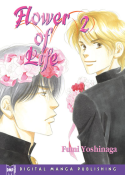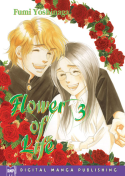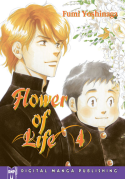By Fumi Yoshinaga | Published by Digital Manga Publishing
 When Fumi Yoshinaga sets a series in high school, you just know that she’s not going to do it like anybody else.
When Fumi Yoshinaga sets a series in high school, you just know that she’s not going to do it like anybody else.
Harutaro Hanazono is beginning his first year of high school thirteen months behind schedule due to a bout of leukemia. The manga begins as he introduces himself to his new classmates in a manner that communicates much about his character. He’s an honest, simple, and idealistic soul, so is very forthright with his classmates about his illness because he doesn’t like the prospect of keeping secrets from all of them or having to explain multiple times. What he fails to consider, however, is how this information will affect his classmates’ interactions with him, since they all treat him with more consideration than they might otherwise have done.
Harutaro quickly becomes friends with Shota Mikuni, a gentle, smart, and adorable overweight boy whose main flaw is his timidity. Mikuni is also friends with Kai Majima, an arrogant otaku who is such a fascinating character that he’s going to get his own paragraph later. Harutaro and Majima don’t get along very well, but this doesn’t stop Harutaro from joining Mikuni and Majima in the manga club, where he collaborates with Mikuni and gradually develops the ambition to become a professional manga artist.
 Meanwhile, readers become acquainted with the rest of the class in the same organic way any new student would. The homeroom teacher is Shigeru Saito, who at first appears to be an effeminate gay man but who is actually a woman. (Yoshinaga fooled me there, I must admit.) Other classmates include Yamane, a mature student with a love for books; Sakai, a perpetually tardy girl with a knack for English; Aizawa, a girl sensitive to the feelings of others; Jinnai and Isonishi, close friends and nice, normal girls; Ozaki, a rather boisterous fellow; and Tsuji, a guy who looks so much like Ono from Antique Bakery that it’s disconcerting to see him nurturing feelings for a woman.
Meanwhile, readers become acquainted with the rest of the class in the same organic way any new student would. The homeroom teacher is Shigeru Saito, who at first appears to be an effeminate gay man but who is actually a woman. (Yoshinaga fooled me there, I must admit.) Other classmates include Yamane, a mature student with a love for books; Sakai, a perpetually tardy girl with a knack for English; Aizawa, a girl sensitive to the feelings of others; Jinnai and Isonishi, close friends and nice, normal girls; Ozaki, a rather boisterous fellow; and Tsuji, a guy who looks so much like Ono from Antique Bakery that it’s disconcerting to see him nurturing feelings for a woman.
Because Yoshinaga introduces the cast of students in such a natural-feeling way, I found myself caring about them much more than I ordinarily do in a series set in high school. For one thing, I’m not sure there is any other series where I could rattle off the names and personality traits of seven supporting classmates. It doesn’t matter that these characters may not get tons of page time; they’re still fully realized people with their own problems and passions. I’ve written before about my weariness regarding school cultural festivals, but in Yoshinaga’s hands, the festival in the second volume of the series is the best I have ever read, hands down. For the first time, I really engaged with the excitement the characters were experiencing. The same holds true for the Christmas party they hold in volume three. (Plus, that dinky tree was genuinely amusing.)
One of the major things I love about Flower of Life is how Yoshinaga works in some subtle lessons on friendship into the story. Sumiko Takeda is not in Harutaro’s class but becomes friendly with them when her original shoujo manga is circulated around and becomes a hit. Takeda doesn’t care about fashion or clothes, and she’s at a loss when her mother gives her some money to buy an outfit for herself. While shopping, she runs into Jinnai and Isonishi, who decide to come along as consultants. Their first shopping experience is kind of a drag, as Takeda is unenthused by the clothes shopping and Jinnai and Isonishi are bored when Takeda geeks out in an art supply store, but on a second attempt, they’re able to work out an arrangement where everyone can pursue their individual interests and yet still have a good time together. This seems to say “You can like different things and still be friends.” Other lessons that crop up later include “You don’t need to try to impress your friends,” “There can be one-sided feelings even in friendship,” and “You might think it’s nice to be coddled, but is it really good for you?”
 Another lesson, “You can disagree and still be friends,” is vitally important to Mikuni. He begins the series a timid guy, unwilling to stand out by expressing his opinion. When he gets passionate enough about something, though—and it’s usually manga—he will speak out. The first time this happens with Harutaro, Mikuni is worried that he’s damaged their friendship, but Harutaro is actually thrilled that Mikuni was able to express himself so honestly and their friendship deepens as a result. By the end of the series, Mikuni has gained enough confidence to express his vision to Takayama, the manga editor who gives their work a harsh critique, and rebound from criticism with a zeal to improve.
Another lesson, “You can disagree and still be friends,” is vitally important to Mikuni. He begins the series a timid guy, unwilling to stand out by expressing his opinion. When he gets passionate enough about something, though—and it’s usually manga—he will speak out. The first time this happens with Harutaro, Mikuni is worried that he’s damaged their friendship, but Harutaro is actually thrilled that Mikuni was able to express himself so honestly and their friendship deepens as a result. By the end of the series, Mikuni has gained enough confidence to express his vision to Takayama, the manga editor who gives their work a harsh critique, and rebound from criticism with a zeal to improve.
I’ve talked quite a lot about the student characters, but the adults figure into the story in big ways, as well. The manga club members discover early on that Saito-sensei is carrying on an affair with the very married Koyanagi-sensei, who used to be her teacher when she was a student ten years ago. Their troubled relationship dominates her thoughts until she finally calls it off in volume three, saying that she loved him because he was such a good father, and it pains her to see him sneaking around and betraying his family. Koyanagi’s unexpected successor is Majima, whose solution to Saito’s woes is to give her something else to be “moeh” about.
And now we come to Majima. I love that in painting this portrait of an otaku, Yoshinaga didn’t just give us a heavy-breathing perv with a penchant for maid costumes, but really shows us how he thinks and attempts to process the world. He is arrogant and a little creepy, with a large quantity of disdain for his fellow students. He seems to prefer 2-D representations of women with specific physical qualities over real women, whom he appears to resent. And yet… although initially detached and unfeeling in his relationship with Saito, he eventually comes a bit unhinged when her behavior—saying she loves him yet sleeping with Koyanagi—does not follow logical patterns. I don’t think he loves her, or is capable of really loving anyone, but he expected her feelings for him to stay the same—the only thing he knows about relationships he’s learned from manga and dating sims, where you win the girl and then she loves you always—and is completely thrown when this doesn’t turn out to be the case. I think the experience makes him a tiny bit more empathetic to others, and maybe it’ll be what he needs to become a better person, but man, how thoroughly unfair of Saito to embroil this poor kid in an adult love triangle that he was not remotely equipped to participate in. My opinion of her suffered a great deal as a result.
 The plight of Harutaro’s homebound sister, Sakura, also plays a major role in the story, furnishing some surprisingly dark moments and eventually culminating in the revelation that Harutaro is not, as he had believed, fully cured. He takes the news hard, but once he’s had the chance to process it, he returns to school for his second year a changed man. For, you see, he has learned to lie. He has learned to consider the feelings of others before he speaks. Gone is the Harutaro that can’t abide secrets. Now we see that he has learned discretion—he might want to tell Mikuni the truth, but he will wait for a time when his friend is ready to hear it. He can keep it to himself for as long as it takes. He has grown up.
The plight of Harutaro’s homebound sister, Sakura, also plays a major role in the story, furnishing some surprisingly dark moments and eventually culminating in the revelation that Harutaro is not, as he had believed, fully cured. He takes the news hard, but once he’s had the chance to process it, he returns to school for his second year a changed man. For, you see, he has learned to lie. He has learned to consider the feelings of others before he speaks. Gone is the Harutaro that can’t abide secrets. Now we see that he has learned discretion—he might want to tell Mikuni the truth, but he will wait for a time when his friend is ready to hear it. He can keep it to himself for as long as it takes. He has grown up.
Lastly, I wanted to touch upon the art in the story, especially the nonverbal storytelling that Yoshinaga employs with such aplomb. The page below is from volume three, when Harutaro has gone to the hospital for his monthly exam. He speaks with the nurse about a fellow patient who has since died, and when he emerges from the hospital, he pauses to look up at the sky for a moment then continues on his way. He doesn’t say a thing, but it his thoughts are absolutely clear: “She will never see this sky again.”
Another trait of Yoshinaga’s art is the repetition of similar panels to highlight the evolution of a facial expression (see MJ’s example from Antique Bakery in a Let’s Get Visual column from last October) or situation. In the example below, from volume four, she not only uses this technique to show Majima as someone not fully invested in the drama of the moment, but also for simple humorous effect.
Flower of Life is really an extraordinary series. When Harutaro and Mikuni are working on their manga, they express the desire to include some universal truths about friendship and growing up in their story, and that is precisely what Fumi Yoshinaga has done. It’s funny, it’s touching, and it’s a classic. Go read it.
Flower of Life was published in English by Digital Manga Publishing and is complete in four volumes. I reviewed it as part of the Fumi Yoshinaga Manga Moveable Feast, the archive of which can be found here.
Review copy for volume four provided by the publisher.








Antique Bakery has a special place in my heart because it was the first work of hers I read but Flower of Life is Yoshinaga at the height of her powers. Not even a single panel is wasted.
Lovely review, and enjoyed your comment about Harutaro looking at the sky and thinking about his friend who will never do that again. I read manga so quickly some of this emotional content can just slip by me, unnoticed.
I agree with your first paragraph 100%. I will always love Antique Bakery passionately, but Flower of Life is an extremely close second. Maybe in time it will eclipse my AB love, especially as I further ponder its marvelous ending.
And thank you! I suppose this is one virtue of being an extremely slow reader like me. 🙂
Okay that last page SLAYS ME AGAINNNNNNNNNNNNNN!
Do you mean the last image above slays you with laughter or the last page of the series slays you with bittersweet awesomeness? Or perhaps both? 🙂
That last page = image you just posted there ^^ among the various images you posted here.
Ah, got it. 🙂 I even showed it to hubby, who doesn’t read manga, and he laughed.
Man, speaking of Majima reminds me: has anyone on the bookshelf done a “favorite Yoshinaga character” list? Cus he’s just have to be on mine somehow, despite being one of the biggest jerks Yoshinaga has ever put in one of her manga, lol!
I don’t think anyone has done such a list, no. I thought about it, but there are still too many of her works that I haven’t read, so I didn’t want to commit to a top three only to find someone else worthy. 🙂
That said, Majima would definitely be on my list. I also dearly love Chikage from Antique Bakery, another intimidating-looking-but-somewhat-dim handsome guy, though he is about as pure-hearted and innocent as it gets. At present, the third spot would go to Tachibana from Antique Bakery.
I’m not a member of the bookshelf, but I did just post a list of my favorite Yoshinaga characters for the Manga Moveable Feast. 🙂
Excuse the plug, Michelle.
http://comicattack.net/2011/08/mmfyoshinagafavechars/
This article makes me want to read the series all over again. Very nice! Oh, and in case anyone is interested, Akadot Retail is selling bundles of Flower of Life 1-3 for $10!
http://www.akadot.com/flower-of-life-vol-0103-gn-bundle-p-23574.html
I think they are also selling Antique Bakery bundles.
Thank you! And thanks for pointing that out about Akadot. Lissa Pattillo rounded up a bunch of deals on Yoshinaga manga in a post today.